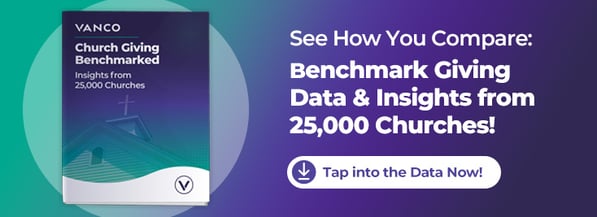 If you’re skeptical about the impact of recurring donations for churches, consider the following giving statistics:
If you’re skeptical about the impact of recurring donations for churches, consider the following giving statistics:
- Monthly givers donate 440% more over their lifetimes than one-time donors (Philanthropy News Digest).
- Recurring givers donate 42% more in a year than one-time givers (Network for Good).
- Monthly donors have a retention rate (the percentage of people who continue to give) of 90% while the average giver only has a 46% retention rate (Causevox).
- In Vanco's benchmark study of 25,000, churches, we found recurring donors donated twice as much as nonrecurring donors.
Churches using recurring giving can expect:
- More predictable giving – when members of a congregation give a set amount each week or month, there are fewer lulls in gifts, making it easier for your church to manage its budget. Get a closer look at the impact of recurring giving by reading about the experiences of Lexington Park United Methodist Church.
- More thoughtful giving – Recurring giving has much more permanence than writing out a check or putting cash into an offering plate. When users sign up for recurring giving, they commit to giving a set amount until they cancel their regular payments.
- More convenience for givers – According to a U.S. bank study, 76% of Americans carry less than $50 in their wallet at any time. This makes it more difficult for givers to give as they must remember to bring their checkbooks or cash, which they can easily forget.
- Recurring giving over the summer - Donations don't take vacations, but your members do, which means they often take their gifts with them. For most churches, the summer giving slump is very real. That’s why recurring giving can ensure members’ gifts don’t go with them while they are away from church.
Simplified giving for a virtual ministry – Many churches have members who winter in warmer climates, but still watch church services online. Recurring giving offers these members an avenue to express their generosity while they are away. And when churches needed to close their doors during COVID-19, recurring giving gave a convenient method for members to express their generosity while they were away.

How to Boost Recurring Giving
We’ve worked with tens of thousands of churches for decades and have found tested approaches any church can use to boost giving. If your church is looking to increase recurring giving, try these 10 tips.
1) Get Buy-In from Church Leaders
One of the biggest reasons church initiatives fail is that they never received buy-in from church leaders. Before rolling out recurring giving for your church or launching a campaign to expand its use, your senior leadership should have gained consensus on your plan. When it comes to growing recurring giving, it comes down to more than a simple yes or no from your leaders. Your leadership team should agree on every aspect of your rollout or campaign.
2) Enlist Church Leaders to Promote Recurring Giving
Within every congregation, there are folks that take an active role in the church’s activities. These include Sunday school teachers, youth directors and laypeople. When rolling out or launching a campaign to expand recurring giving, churches should ask these folks to model the new behavior.
This could include them offering a brief demonstration of your recurring giving software, or you could ask them to discuss the impact recurring donations had on a mission within the church. By getting your leaders to agree to model recurring giving, you’ll increase your congregation’s comfort level with the new change.
3) Reframe the Ask
Once your church decides to commit to rolling out or expanding recurring giving, you’ll need to reframe the way you ask for gifts to be more specific. This means your church should ask for monthly or weekly gifts. This is perhaps the easiest change any church can make, and surprisingly, it has one of the biggest impacts on financial stewardship of any of the 10 tips.
4) Give Givers a Reason
Many members are averse to change, but if churches explain the value of recurring giving, many will make the adjustment. There are plenty of benefits for recurring giving for both the giver and the church. For members, giving becomes easier. Churchgoers don’t need to remember to bring their checkbook, wallet or to give their gift electronically every week. Recurring giving only takes a few minutes to set up, and there is no need for them to manage their donations afterwards.
As for churches, donations become more predictable and reliable. It also simplifies administration, as your eGiving platform should collect and collate the data in a way that makes record-keeping and issuing end-of-year tax documents simple.
Mentioning each of these points to your congregation will help, but for churchgoers to truly embrace recurring giving, you’ll need to go a little deeper. It’s important to connect recurring giving to your mission, by explaining what has already been done thanks to the new emphasis on automatic gifts, or what will be done by the new initiative.
This is where your church can talk about the good it has done in the community and beyond. You can even speak to your plans to grow outreach to connect with even more people. One of the reasons churchgoers become members is to be a part of something bigger. Your church fulfills this need, but only if you show them what good works came from their resources.
When givers hear the impact their resources had on the community and those in need, they’ll be inspired to give more.
5) Show How Easy Recurring Giving Is
One of the most effective ways to encourage members to sign up is by showing them exactly how easy it is to donate. The most successful of the 22,000 churches we’ve worked with will demonstrate how quickly members can set up recurring giving. For example, Vanco’s software allows members to set up recurring giving with a text, a mobile app or online. In each case, the process is fewer than five steps and only takes a few minutes.
If your church has a projector and a laptop, you can demonstrate the process in just a minute. Or, you can create instructional videos to post on your website using a screencast. Don’t worry. You don’t need to be a master director to pull it off. Using a free online screencast, such as Screencast-O-Matic, you can create a video recording of the signup process within a minute. All you need to do is click record on whatever screencast software you use and complete a recurring gift. Then you can either upload the video to YouTube to post as a link within your website (click here for instructions) or upload the video file to your website.
6) Respect the Tradition of the Offering Plate
Many churchgoers have placed their weekly donation in offering plates all their lives, which is why churches offering eGiving options such as recurring giving will use offering cards. Churches print these cards and put them within their pews for people to place in the offering plate. When churches use the cards, they allow churchgoers to participate in a tradition they’ve grown accustomed to.
7) Promote Recurring Giving for the Church
Recurring giving for churches needs to be promoted to get new givers on board. There are several ways you can get the word out about recurring giving including…
- Displaying posters detailing the recurring giving options available to them and offering instructions for setting up.
- Sending letters in the mail to promote recurring giving. Sending emails to promote automatic giving.
- Creating a page on your church’s website promoting eGiving.
- Promoting recurring giving through social media posts.
- Including messages promoting recurring giving within church bulletins.
- Speaking about recurring giving from the pulpit.
Creating promotional materials for recurring giving can be a bit of work, which is why we’ve created dozens of templates and samples to help. Any church can use our message templates or use our sample posters as a springboard for their own.
8) Be Persistent
Getting members to switch to recurring giving won’t happen overnight. That’s why churches need to be persistent. Mention the recurring giving option regularly, especially as you launch your first campaign to get churchgoers to sign up.
9) Make the Ask Small
You’ve probably seen commercials for nonprofits asking for a microdonation of just a few dollars. They do this because the lifetime value of that small but regular donation often adds up to be higher than that of a large one-time donation. After all, the average life of a recurring donation among nonprofits is 1.73 years.
The other reason, which is often overlooked, is that many recurring givers will give additional gifts outside their regularly scheduled donation. They will often increase their donation too. Starting out small gives donors more time and practice balancing donations as a component of their budget. Over time, these givers get more confident about their ability to support the church’s mission and increase their contributions to their new comfort level.
10) Say Thank you
We saved the most important for last. Your givers make all the good work your church does possible. That’s why you need to thank them routinely. When it comes to giving thanks, it’s important to make sure you give each communication a personal touch.
Don’t lean on a blanket thank you from the pulpit to the congregation. Personalize your thank-you messages. This could include sending out handwritten letters to your givers on a quarterly basis. Or, if you really want to make sure your givers are appreciated, you could organize a Thank-a-Thon. This involves calling members who donated past a certain threshold. Not all the responsibility for calling and reaching out needs to fall solely on your clergy’s shoulders. You can enlist church leaders to help. Whatever you do, make sure the amount of each giver’s donations is unknown to your church volunteers. Although many givers want to be acknowledged for their contributions, they’re uncomfortable with others knowing how much they give.
How to Get Started with Recurring Giving
As we mentioned earlier, setting up recurring giving is easy. Most eGiving options have a box that allows givers to make their donation recurring. To see how you can set up recurring giving for your church, give us a call or request a free demo of our eGiving options.
Don’t Let Your Church Suffer from Declining Donations
Discover how you can easily grow giving for your church with the 11-step process that has worked for tens of thousands of churches.












